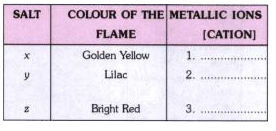What type of flame is employed to perform the flame test? How is it obtained?
Step-by-Step Solution:
1. Identify the Type of Flame Used:
The flame test is performed using a non-luminous flame. This type of flame is preferred because it provides a clear background for observing the colors produced by different metal ions.
2. Understanding Non-Luminous Flame:
A non-luminous flame is characterized by its blue color and is less sooty compared to a luminous flame. It is more efficient for heating and provides a stable environment for the flame test.
3. How to Obtain a Non-Luminous Flame:
To obtain a non-luminous flame, the air supply to the burner must be adjusted. This is done by partially opening the air holes of the burner. When the air holes are opened, more oxygen mixes with the gas, resulting in complete combustion and producing a non-luminous flame.
4. Performing the Flame Test:
Once the non-luminous flame is obtained, a sample of the salt to be tested is introduced into the flame using a clean wire loop. The color of the flame is then observed, which indicates the presence of specific metal ions.
The flame test is performed using a non-luminous flame. This type of flame is preferred because it provides a clear background for observing the colors produced by different metal ions.
A non-luminous flame is characterized by its blue color and is less sooty compared to a luminous flame. It is more efficient for heating and provides a stable environment for the flame test.
To obtain a non-luminous flame, the air supply to the burner must be adjusted. This is done by partially opening the air holes of the burner. When the air holes are opened, more oxygen mixes with the gas, resulting in complete combustion and producing a non-luminous flame.
Once the non-luminous flame is obtained, a sample of the salt to be tested is introduced into the flame using a clean wire loop. The color of the flame is then observed, which indicates the presence of specific metal ions.
Topper's Solved these Questions
- QUALITATIVE INORGANIC SALT ANALYSISBOOK - CENGAGE CHEMISTRY ENGLISHCHAPTER - QUALITATIVE INORGANIC SALT ANALYSISEXERCISE - Viva Voce Questions And Part-C (Analysis Of Cations)
42 Videos
- QUALITATIVE INORGANIC SALT ANALYSISBOOK - CENGAGE CHEMISTRY ENGLISHCHAPTER - QUALITATIVE INORGANIC SALT ANALYSISEXERCISE - Viva Voce Questions And Part-A (Analysis Of Anions)
30 Videos
- P-BLOCK GROUP 18 ELEMENTS - THE INERT GASESBOOK - CENGAGE CHEMISTRY ENGLISHCHAPTER - P-BLOCK GROUP 18 ELEMENTS - THE INERT GASESEXERCISE - Ex 5.1 (Objective)
14 Videos
- REDUCTION AND OXIDATION REACTION OF ORGANIC COMPOUNDSBOOK - CENGAGE CHEMISTRY ENGLISHCHAPTER - REDUCTION AND OXIDATION REACTION OF ORGANIC COMPOUNDSEXERCISE - SUBJECTIVE TYPE
4 Videos
Similar Questions
Flame test is not given by
View SolutionHow is a flame test performed ?
View SolutionWhat type of flame is given by benzene on burning?
View SolutionWhy do alkali metals respond to flame test?
View SolutionThe spectrum of an oil flame is an example for
View SolutionThe metallic ions (the cations) can be identify by performing flame test which is describe below.
"Make a paste of the given salt in concentrated hydrochloric acid. Load the paste on a clean platinum wire and introduce it in a non-luminous bunsen burner flame. Note the colour of the flame imparted by the flame. Tabulate your answer in the formate given below. The salt x imparts golden yellow flame. The salt y imparts lilac flame and the salt z imparts bright red flame.

View SolutionThe pair of metals which do not impart colour in flame test is
View SolutionIdentify the salts P from the observations given below:
On performing the flame test salt P produces a lilac coloured flame and its solution gives a white precipitate with silver nitrate solution, which is soluble in Ammonium hydroxide solution.
View SolutionWhat colour is imparted by Rubidium in flame test?
View SolutionWhat colour is imparted by Rubidium in flame test?
View Solution
